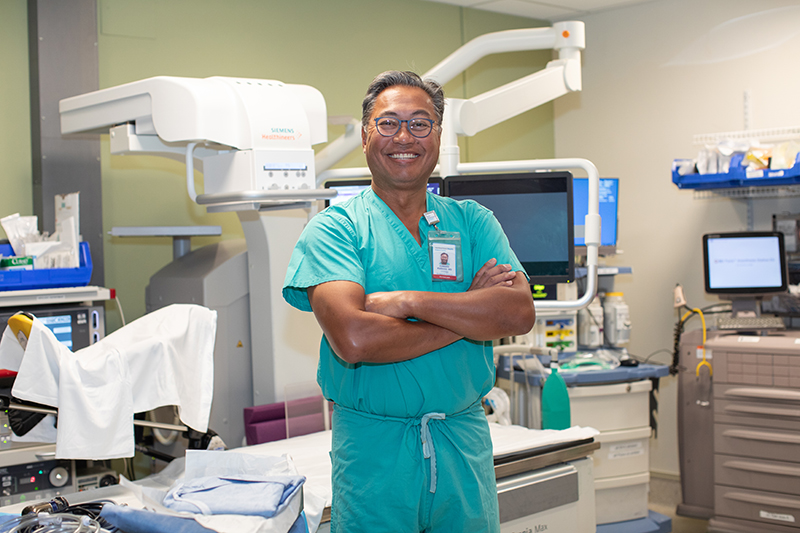
Popular Locations
- Outpatient Surgery - Bridgeport Hospital
- Park Avenue Medical Center
- Primary Care Center - Bridgeport Hospital

Published April 11, 2024

When King Charles III was treated for an enlarged prostate – also known as benign prostatic hyperplasia (BPH) – earlier this year, the world took notice. While many men may choose to ignore the symptoms of an enlarged prostate – such as the need to urinate frequently throughout the night or endure a slow urine stream – getting checked out can offer options for symptom relief as well as rule out prostate cancer.
“One of the most bothersome features of BPH is getting up several times a night to urinate,” said Edward Paraiso, MD, a urologist with Northeast Medical Group who is affiliated with Bridgeport Hospital. “For some men, that is the most bothersome because they lose sleep, and then during the day they may feel like they have to go to the bathroom frequently, or they have to rush to get there.”
“This is what usually drives men into the doctor to seek treatment,” Dr. Paraiso said.
BPH, a benign growth of the prostate gland that sits below the bladder in males, is a common condition affecting about 40 million men in the United States. About 12 million men are managed either with surgery or pharmaceutical therapy.
“BPH is the most common reason why men see a urologist,” Dr. Paraiso said. “About one in two men will develop BPH, usually between the ages of 50 and 60.”
The average size of the prostate for a man 50 or older is 30 to 40 grams – the size of a walnut, Dr. Paraiso explained. As men age, the prostate continues to grow and, in extreme cases, it can grow to 200 to 300 grams – the size of a plum or an orange.
Dr. Paraiso said some men who have BPH have had it for years. “It usually takes that long for men to get in a doctor’s office,” he said.
Fear may be the reason some men put off getting their prostate checked. “Men who have symptoms of BPH often worry that they are going to develop cancer of the prostate,” Dr. Paraiso said, “but having BPH does not predispose men to having prostate cancer.”
A prostate exam is recommended, however, to make sure those who have an enlarged prostate don’t have cancer.
“Prostate cancer generally doesn’t have symptoms,” Dr. Paraiso noted. “That’s why it’s important for men to get a rectal exam and a PSA test once a year.”
A PSA test is a blood test used to screen for prostate cancer. It measures the amount of prostate-specific antigen in the blood, a protein produced by both cancerous and noncancerous tissue in the prostate.
Dr. Paraiso recommends prostate exams start at age 50. If there is a family history of prostate cancer or other risk factors, the recommended starting age is 40.
“First, we do a screening – a rectal exam – to see how large their prostate is, to make sure there are no nodules in the prostate.” Dr. Paraiso explained. “We also do a PSA test to screen for prostate cancer. If those exams are normal, but the patient is having symptoms, I ask, ‘Are they bothersome to you?’
“So, it’s a quality-of-life issue, and they’re really the only ones who will know whether they want treatment or not. The only time we’d really have to treat a patient for BPH is if they weren’t emptying their bladder completely, or if they were having urinary tract infections,” Dr. Paraiso explained.
Dr. Paraiso first reviews dietary modifications that will help patients improve their symptoms. “This includes avoiding caffeinated drinks or alcohol and foods that irritate the bladder or prostate that make you go frequently; also, decreasing fluid intake after 7 pm, so that you’re not getting up as much at nighttime.” Patients who are prescribed diuretics should take them no later than in the afternoon to decrease the incidence of urinary frequency after bedtime.
“If those modifications don’t work, then we start with medications,” Dr. Paraiso said. “There are two types of medications that will help alleviate the blockage: alpha blockers will help relax the muscles around the prostate and bladder, and 5-alpha reductase inhibitors will help decrease the size of the prostate.” As with all medications, patients should discuss possible side effects with their doctor.
If medications don’t provide relief, surgery may be warranted. Surgical procedures such as Urolift™, Green Light™ laser ablation of the prostate, or transurethral resection of the prostate (TURP), do not involve any cutting of the skin and are selected based on the size of the prostate.
“For very large prostates, we do what is called a robotic-assisted simple prostatectomy,” he explained. “Instead of taking out the whole prostate, like we do for cancer surgery, we take out the part of the prostate that is causing the blockage.”
Everything other than the simple prostatectomy can be done as an outpatient procedure; a simple prostatectomy usually requires an overnight stay, Dr. Paraiso said. All surgeries are done at Bridgeport Hospital or at Park Avenue Medical Center in Trumbull.
Learn more about urological services for men at Bridgeport Hospital.
*YNHHS uses the terms "female" and "male" to reflect biological status typically assigned at birth, and "women" and "men" when referring to gender. Gender identification may differ from birth sex.